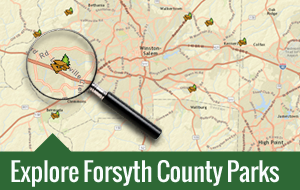Tanglewood is rich in history, beauty, and southern charm. Tanglewood’s story lies not only beneath the surface, but can be experienced as an ongoing living process. The property now known as Tanglewood Park was part of land claimed by Sr. Walter Raleigh for Queen Elizabeth on March 25, 1584. John Cartaret, 2nd Earl Granville acquired a sixty mile stretch of land in western North Carolina in the early 1700’s known as the Granville District, granting land to those who had established surveys. William Linville, who settled with his family from Virginia and Pennsylvania by 1747/1748, acquired seven grants along the Yadkin around the shallow ford. More European settlers arrived in the Yadkin River Valley, including William Johnson, an immigrant from Wales. In 1757, ten years after Linville built a cabin on it, and just four years after the Moravian settlement of the Wachovia Tract in the nearby communities of Bethabara and Salem, Johnson purchased the mile square central portion of what became Tanglewood from the William and Ellender Linville.
After obtaining the property, Johnson built a fort overlooking the Yadkin River to protect his family and neighbors from attacks during the French and Indian War. Currently, this spot is marked by a monument just south of the Manor House. In 1765 he died and is now buried on the highest hill in the area called Mount Pleasant. In 1809 a simple frame church was erected next to his grave and remains today as one of the park’s architectural attractions. Although services are no longer held there, many people are united in marriage at the Mount Pleasant Church each year.
In 1859, James Johnson had the eighteen-room Manor House built on a hill in the center of the estate. The house was a gift of love to his daughter, Emily, for a wedding present. Two wings were added later.
The Johnson heirs sold their property in 1921 to William Neal Reynolds, brother of tobacco entrepreneur R.J. Reynolds. At that time the Tanglewood tract was enlarged to over 1,100 acres and the Manor House expanded to twenty-eight rooms. Mr. Will, as he was called, raised and raced thoroughbred harness horses and established Tanglewood Farm as a home to some of the country’s finest pacers. In the Manor House, Mr. Will had a special room dedicated to his trophies, called the "Trophy Room." A fire that started mysteriously in a trophy room display case in 1980 did considerable damage, but the room has been restored. The room is surrounded by plaques and horse photographs. It is obvious that Mr. Will was a horse lover, and this tradition is carried on with Tanglewood Farm. Trail rides, hayrides, and carriage rides are available by reservation.
Today, the Manor House is a Bed & Breakfast Inn with ten guest rooms, sweeping staircases, the Trophy Room, 20’s Room, and Rock Fireplace Room. These facilities are used for weddings, meetings, and overnight accommodations. It is rumored that Mr. Will’s spirit makes friendly visits to the house from time to time.
Mr. Will’s wife, Kate, a horticultural enthusiast, began the extensive native and ornamental plantings at Tanglewood and employed German master gardener, Mr. Frank Lustig, who continued her plans and his life’s work. He contributed the 800-bush Rose Garden on the Manor House lawn, the Arboretum behind the house, and the nearby Fragrance Garden to the Estate. For 60 years, even after the death of his employers and their gift of the estate, Lustig poured his talents into Tanglewood. He is buried in the graveyard at Tanglewood next to the historic church.
In 1951, the Reynolds willed the Tanglewood property to the citizens of Forsyth County to share as a public recreational park. The couple had no children. The Reynolds willed the property as a gesture to have others benefit from the beauty, elegance, history, and recreation their country estate had to offer. Thus, Tanglewood Park was born. The public recreational facility is owned by Forsyth County.
The combination of its streams, woodlands, and grassy pastures with the traditions of its architecture, horses, gardening, and wide range of recreational activities make Tanglewood an ideal countryside park to visit over and over again. Whether your journey brings you on business or pleasure, we offer something for everyone.
How Tanglewood Got Its Name
There are several stories on how Tanglewood was named. One version is that, while strolling through tangled underbrush where timber had been cleared, the name occurred to Kate Reynolds.
Another version is that the heirs to the Johnson family had noticed the tangled undergrowth. Kate Reynolds read Tanglewood Tales by Nathaniel Hawthorne frequently to her children, and named the family farm Tanglewood. Apparently, Mr. Will asked if the name could be continued after his possession of the property, and the Johnson heirs said they would be honored.
Both stories are told, no one thus far can prove either one. The reader should decide which story they prefer to believe. Kate Reynolds wrote this poem about Tanglewood:
"The seat of creeks and mighty trees,
Of fertile soil and balmy breeze . . .
Twould fill a page, had I a book,
To tell the joys of Tanglewood!"
















